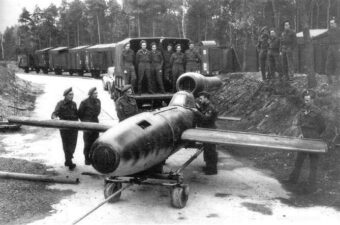“Unveiling the Bizarre: How Nazi Germany Crafted a Wooden Weapon of War That Defied Belief”
38 years old at the time, Fieseler had until 1942 been the technical director of Fieseler, where he had contributed to the design of the highly-successful Fi 156 Storch military liaison aircraft. In February 1942, however, he left the company to form Bachem-Werke GmbH, an aircraft parts supplier based in Waldsee. Bachem’s submission for the Emergency Fighter Program neatly solved most of the issues which had plagued previous air defence weapons, such as the need for vulnerable runways for takeoff and landing; and the need for sophisticated automatic guidance systems. Instead of taking off from a runway, Bachem’s rocket-powered fighter was launched vertically from a tower like a missile, though unlike a missile it was guided to its target by a human pilot. After completing its mission the craft, which had no landing gear, simply split apart, with the pilot and the expensive rocket engine parachuting back to earth to be reused for a future mission.
A similar design had been proposed by Wernher von Braun, designer of the infamous V-2 ballistic missile, back in 1939, but this had been rejected by the RLM. And despite Germany’s desperate situation and the many advantages of Bachem’s design, it too was turned down in favour of the more conventional Heinkel P.1077 proposal. Undeterred, Bachem sought the help of decorated Luftwaffe ace and General Adolf Galland to push through his design, but once again the RLM was uninterested. Thankfully, however, the inter-service rivalry rampant in Nazi Germany soon came to Bachem’s rescue as his design caught the attention of Reichsführer Heinrich Himmler, head of the SS. Impressed by the proposal, Himmler signed an order to build 150 aircraft using SS funds, tapping SS-Obergruppenführer Hans Kammler to head the development effort. Kammler had already played a leading role in another secret weapons program, creating the infamous Mittelwerk underground factory at Nordhausen, where V-2 ballistic missiles were built using slave labour. Indeed, Kammler proposed a similar arrangement for producing this new interceptor, but Erich Bachem vehemently opposed this suggestion. Meanwhile, realizing that the SS was developing an aircraft outside their jurisdiction, the RLM placed their own order for 50 airframes, which they officially designated the Bachem Ba 349 Natter. And as side note, while many sources translate “Natter” as “adder” or “viper”, the term actually refers to non-venomous species such as the common European grass snake.










